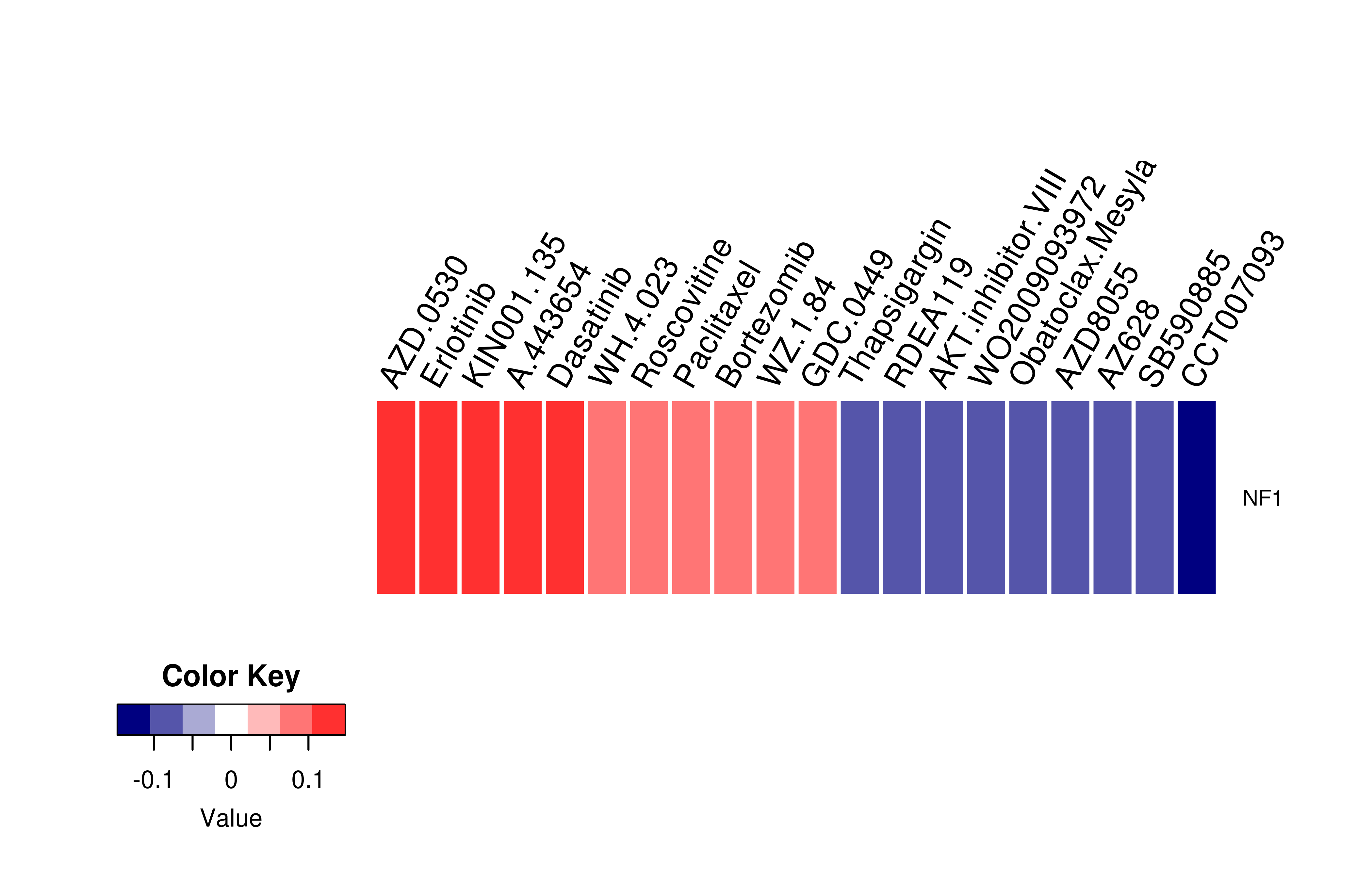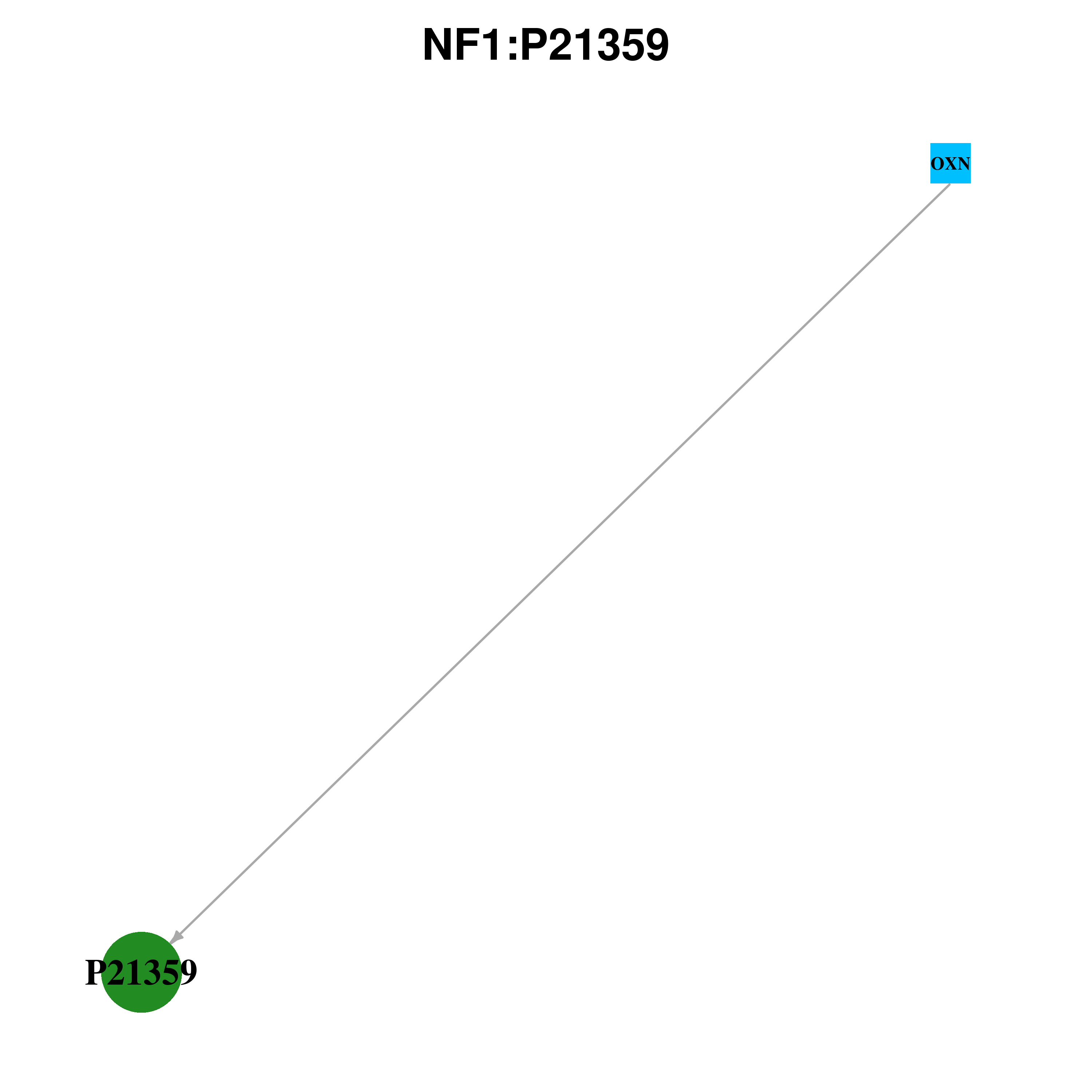|
mutLBSgeneDB |
| |
| |
| |
| |
| |
| |
|
| Gene summary for NF1 |
 Gene summary Gene summary |
| Basic gene Info. | Gene symbol | NF1 |
| Gene name | neurofibromin 1 | |
| Synonyms | NFNS|VRNF|WSS | |
| Cytomap | UCSC genome browser: 17q11.2 | |
| Type of gene | protein-coding | |
| RefGenes | NM_000267.3, NM_001042492.2,NM_001128147.2, | |
| Description | neurofibromatosis-related protein NF-1neurofibromin | |
| Modification date | 20141219 | |
| dbXrefs | MIM : 613113 | |
| HGNC : HGNC | ||
| Ensembl : ENSG00000196712 | ||
| HPRD : 01203 | ||
| Vega : OTTHUMG00000132871 | ||
| Protein | UniProt: P21359 go to UniProt's Cross Reference DB Table | |
| Expression | CleanEX: HS_NF1 | |
| BioGPS: 4763 | ||
| Pathway | NCI Pathway Interaction Database: NF1 | |
| KEGG: NF1 | ||
| REACTOME: NF1 | ||
| Pathway Commons: NF1 | ||
| Context | iHOP: NF1 | |
| ligand binding site mutation search in PubMed: NF1 | ||
| UCL Cancer Institute: NF1 | ||
| Assigned class in mutLBSgeneDB | A: This gene has a literature evidence and it belongs to targetable_mutLBSgenes. | |
| References showing study about ligand binding site mutation for NF1. | 1. Wehrle-Haller, B., Meller, M., & Weston, J. A. (2001). Analysis of melanocyte precursors in Nf1 mutants reveals that MGF/KIT signaling promotes directed cell migration independent of its function in cell survival.Developmental biology, 232(2), 471-483. 11401406 | |
 Gene ontology having evidence of Inferred from Direct Assay (IDA) from Entrez Gene ontology having evidence of Inferred from Direct Assay (IDA) from Entrez |
| GO ID | GO Term | PubMed ID | GO:0032320 | positive regulation of Ras GTPase activity | 2121371 |
| Top |
| Ligand binding site mutations for NF1 |
 Lollipop-style diagram of mutations at LBS in amino-acid sequence. Lollipop-style diagram of mutations at LBS in amino-acid sequence. We represented ligand binding site mutations only. (You can see big image via clicking.) |
 |
 Cancer type specific mutLBS sorted by frequency Cancer type specific mutLBS sorted by frequency |
| LBS | AAchange of nsSNV | Cancer type | # samples | W1662 | W1662L | COAD | 2 | W1662 | W1662R | COAD | 1 | F1666 | G1668V | LUAD | 1 | V1674 | N1673S | LUAD | 1 |
| cf) Cancer type abbreviation. BLCA: Bladder urothelial carcinoma, BRCA: Breast invasive carcinoma, CESC: Cervical squamous cell carcinoma and endocervical adenocarcinoma, COAD: Colon adenocarcinoma, GBM: Glioblastoma multiforme, LGG: Brain lower grade glioma, HNSC: Head and neck squamous cell carcinoma, KICH: Kidney chromophobe, KIRC: Kidney renal clear cell carcinoma, KIRP: Kidney renal papillary cell carcinoma, LAML: Acute myeloid leukemia, LUAD: Lung adenocarcinoma, LUSC: Lung squamous cell carcinoma, OV: Ovarian serous cystadenocarcinoma, PAAD: Pancreatic adenocarcinoma, PRAD: Prostate adenocarcinoma, SKCM: Skin cutaneous melanoma, STAD: Stomach adenocarcinoma, THCA: Thyroid carcinoma, UCEC: Uterine corpus endometrial carcinoma. |
 Clinical information for NF1 from My Cancer Genome. Clinical information for NF1 from My Cancer Genome. |
| Neurofibromin 1 (NF1) is a gene that codes for a tumor suppressor protein (Genetics Home Reference 2014). NF1 suppresses the function of the Ras protein, which promotes cell growth and differentiation (Genetics Home Reference 2014; Yap et al. 2014). In cancer, the tumor suppression function of the gene is impaired, leading to conditions favorable for uncontrolled cell growth. NF1 mutations have been observed in multiple cancer types, including myelodysplastic syndromes.In addition, NF1 syndrome is a germline condition resulting in predisposition to several types of cancer, in addition to other effects (Yap et al. 2014). Cancer types associated with NF1 syndrome include glioma, melanoma, lung cancer, ovarian cancer, breast cancer, colorectal cancer, hematologic malignancies, and other cancers (Yap et al. 2014).Related Pathways:Receptor tyrosine kinase/growth factor signaling. Strickland, S.A., Kim, A.S. 2015. NF1. My Cancer Genomehttps://www.mycancergenome.org/content/gene/nf1/ (Updated December 2015) |
| Top |
| Protein structure related information for NF1 |
 Relative protein structure stability change (ΔΔE) using Mupro 1.1 Relative protein structure stability change (ΔΔE) using Mupro 1.1 Mupro score denotes assessment of the effect of mutations on thermodynamic stability. (ΔΔE<0: mutation decreases stability, ΔΔE>0: mutation increases stability) |
 : nsSNV at non-LBS : nsSNV at non-LBS : nsSNV at LBS : nsSNV at LBS |
 |
 nsSNVs sorted by the relative stability change of protein structure by each mutation nsSNVs sorted by the relative stability change of protein structure by each mutation Blue: mutations of positive stability change. and red : the most recurrent mutation for this gene. |
| LBS | AAchange of nsSNV | Relative stability change | W1662 | W1662R | -1.2671558 | W1662 | W1662L | -1.04893 | V1674 | N1673S | -0.46464526 | F1666 | G1668V | -0.35410622 |
| (MuPro1.1: Jianlin Cheng et al., Prediction of Protein Stability Changes for Single-Site Mutations Using Support Vector Machines, PROTEINS: Structure, Function, and Bioinformatics. 2006, 62:1125-1132) |
 Structure image for NF1 from PDB Structure image for NF1 from PDB |
| PDB ID | PDB title | PDB structure | 3PG7 | Crystal structure of the H. sapiens NF1 SEC-PH domain (del1750 mutant) |  |
| Top |
| Differential gene expression and gene-gene network for NF1 |
 Differential gene expression between mutated and non-mutated LBS samples in all 16 major cancer types Differential gene expression between mutated and non-mutated LBS samples in all 16 major cancer types |
 Differential co-expressed gene network based on protein-protein interaction data (CePIN) Differential co-expressed gene network based on protein-protein interaction data (CePIN) |
| Top |
| Top |
| Phenotype information for NF1 |
 Gene level disease information (DisGeNet) Gene level disease information (DisGeNet) |
| Disease ID | Disease name | # PubMed | Association type |
| umls:C0027831 | Neurofibromatosis 1 | 225 | AlteredExpression, Biomarker, GeneticVariation |
| umls:C0206727 | Nerve Sheath Neoplasms | 37 | Biomarker, GeneticVariation |
| umls:C0162678 | Neurofibromatoses | 31 | Biomarker, GeneticVariation |
| umls:C0349639 | Leukemia, Myelomonocytic, Juvenile | 14 | Biomarker, GeneticVariation |
| umls:C0031511 | Pheochromocytoma | 11 | Biomarker, GeneticVariation |
| umls:C0004114 | Astrocytoma | 10 | Biomarker |
| umls:C0023467 | Leukemia, Myeloid, Acute | 9 | AlteredExpression, Biomarker, GeneticVariation |
| umls:C2931482 | Neurofibromatosis-Noonan syndrome | 7 | Biomarker, GeneticVariation |
| umls:C1261473 | Sarcoma | 6 | Biomarker |
| umls:C0004352 | Autistic Disorder | 4 | Biomarker, GeneticVariation |
| umls:C1834235 | Neurofibromatosis, Familial Spinal | 3 | Biomarker, GeneticVariation |
| umls:C0553586 | Caf-au-lait macules with pulmonary stenosis | 2 | Biomarker, GeneticVariation |
| umls:C0023186 | Learning Disorders | 2 | Biomarker, GeneticVariation |
| umls:C0016057 | Fibrosarcoma | 1 | Biomarker |
| umls:C3714756 | Intellectual Disability | 1 | Biomarker |
| umls:C0023827 | Liposarcoma | 1 | Biomarker |
 Mutation level pathogenic information (ClinVar annotation) Mutation level pathogenic information (ClinVar annotation) |
| Allele ID | AA change | Clinical significance | Origin | Phenotype IDs |
| Top |
| Pharmacological information for NF1 |
 Gene expression profile of anticancer drug treated cell-lines (CCLE) Gene expression profile of anticancer drug treated cell-lines (CCLE)Heatmap showing the correlation between gene expression and drug response across all the cell-lines. We chose the top 20 among 138 drugs.We used Pearson's correlation coefficient. |
 |
 Drug information targeting mutLBSgene (Approved drugs only) Drug information targeting mutLBSgene (Approved drugs only) |
| Drug status | DrugBank ID | Name | Type | Drug structure |
 Gene-centered ligand-gene interaction network Gene-centered ligand-gene interaction network |
 |
 Ligands binding to mutated ligand binding site of NF1 go to BioLip Ligands binding to mutated ligand binding site of NF1 go to BioLip |
| Ligand ID | Ligand short name | Ligand long name | PDB ID | PDB name | mutLBS |
| Top |
| Conservation information for LBS of NF1 |
 Multiple alignments for P21359 in multiple species Multiple alignments for P21359 in multiple species |
| LBS | AA sequence | # species | Species | F1654 | GPSNRFKTDFL | 3 | Homo sapiens, Rattus norvegicus, Mus musculus | F1666 | KWFVVFPGFAY | 3 | Homo sapiens, Rattus norvegicus, Mus musculus | H1693 | EYTKYHERLLT | 3 | Homo sapiens, Rattus norvegicus, Mus musculus | I1641 | AKPYEIVVDLT | 3 | Homo sapiens, Rattus norvegicus, Mus musculus | K1655 | PSNRFKTDFLS | 3 | Homo sapiens, Rattus norvegicus, Mus musculus | K1691 | VREYTKYHERL | 3 | Homo sapiens, Rattus norvegicus, Mus musculus | N1805 | TLTIANQGTPL | 3 | Homo sapiens, Rattus norvegicus, Mus musculus | P1650 | LTHTGPSNRFK | 3 | Homo sapiens, Rattus norvegicus, Mus musculus | R1653 | TGPSNRFKTDF | 3 | Homo sapiens, Rattus norvegicus, Mus musculus | R1687 | CNSWVREYTKY | 3 | Homo sapiens, Rattus norvegicus, Mus musculus | S1651 | THTGPSNRFKT | 3 | Homo sapiens, Rattus norvegicus, Mus musculus | T1656 | SNRFKTDFLSK | 3 | Homo sapiens, Rattus norvegicus, Mus musculus | V1643 | PYEIVVDLTHT | 3 | Homo sapiens, Rattus norvegicus, Mus musculus | V1674 | FAYDNVSAVYI | 3 | Homo sapiens, Rattus norvegicus, Mus musculus | W1662 | DFLSKWFVVFP | 3 | Homo sapiens, Rattus norvegicus, Mus musculus | Y1608 | NPIFYYVARRF | 3 | Homo sapiens, Rattus norvegicus, Mus musculus | Y1671 | FPGFAYDNVSA | 3 | Homo sapiens, Rattus norvegicus, Mus musculus | Y1689 | SWVREYTKYHE | 3 | Homo sapiens, Rattus norvegicus, Mus musculus | Y1692 | REYTKYHERLL | 3 | Homo sapiens, Rattus norvegicus, Mus musculus |
 |
Copyright © 2016-Present - The University of Texas Health Science Center at Houston |
